INDUSTRIAL &
TERMINAL RAILROADS &
RAIL-MARINE OPERATIONS
OF BROOKLYN, QUEENS, STATEN
ISLAND, BRONX &
MANHATTAN:
WEST 37TH
STREET FREIGHT STATION & RAILROAD - PIER
77 & 78
Manhattan, NY
PENNSYLVANIA RAILROAD
Pier Station Hudson River Thirty Seventh

.
.
|
updated: |
||
|
|
||
|
update summary: |
date: | chapter: |
| PRR #129 added to roster | 01 October 2023 | |
| PRR #129 added to photos | 01 October 2023 | Locomotive Photos |
.
.

| Property & Trackage | Pier Station | Float bridge | |
| Locomotive Overview & Photos |
Marine Equipment Overview & Roster |
||
.. ..
The date for the start of operations of this facility is unknown, but it is prior to 1897.
According to the 1920 Joint Report with Comprehensive Plan and Recommendations by the New York, New Jersey Port and Harbor Development Commission; the following figures are given.
Pennsylvania Railroad - West 37th Street
|
tonnage handled |
... |
cars handled |
... |
cars handled |
||||||
| inbound |
outbound |
total |
loaded |
empty |
total |
loaded |
empty |
total |
||
|
|
|
|
||||||||
| 108,172 |
64,711 |
172,883 | 12,317 |
1,393 |
13,710 |
9,180 |
4,530 |
1,3710 |
||
This facility would close circa 1975.
.
.
The 1885 E. Robinson Property Map seen below, is the earliest map located thus far that shows the presence of the Pennsylvania RR in the vicinity of West 37th Street in Manhattan.
This "presence" is merely a structure located at the corner
of West 35th Street and Twelfth Avenue, and is clearly marked for
Pennsylvania Railroad and appears to be a simple bulkhead pier station. It
should ne noted that this structure is two blocks south of where the Pennsylvania
RR West 37th Street Freight Yards would actually be located. That property
appears to be multitude of semi improved lots. Also, take note that Twelfth
Avenue ends at West 37th Street. The E. Robinson map legend denotes the
following.
.
blue structures are of iron construction,
pink are of brick construction, and
yellow are of wood construction:

E. Robinson - 1885
.
The 1891 edition of G. W. Bromley Property Map shows that the basin between West 38th and West 39th Street has been partially filled in and Twelfth Avenue has been extended to connect with West 38th Street. This map also shows that the Pennsylvania Railroad now owns most of the block bordered by West 37th and West 38th Streets and Twelve & Eleventh Avenues with the exception of the row of structures along Eleventh Avenue.
This map reflects no trackage or float bridge for the Pennsylvania Railroad, and while the West Shore Railroad property located one block south does not show trackage either, we know from the Robinson map above, it in fact does, and this map also reveals the outline of the float bridge and finger piers for the West Shore facility.
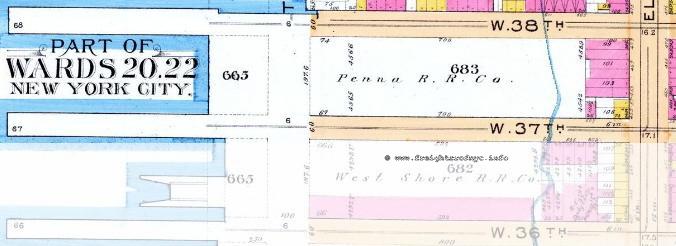
G. W. Bromley - 1891
.
By 1897 edition of the G. W. Bromley Property Map, the outlines of a float bridge and finger piers for the Pennsylvania Railroad are shown, a pier shed ( in light yellow with light blue border) and a structure at the foot of the float bridge (also in light blue with light blue border) has been constructed and marked "Penna RR Co". Oddly, no trackage is shown, for either the Pennsylvania or West Shore Railroad, yet we know the trackage existed.
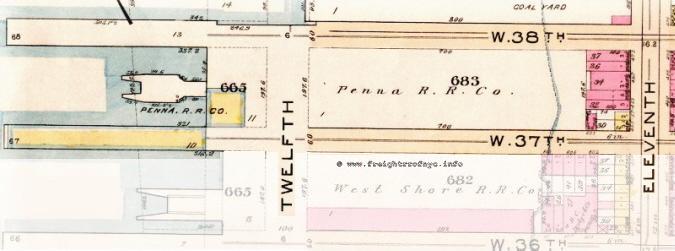
G. W. Bromley - 1897
.
By the next edition of the G. W. Bromley Property Maps, (1909) trackage is now shown for the Pennsylvania RR, and West Shore Railroads. We can also see that the Pennsylvania Railroad has already crossed West 38th Street and expanded to the next block north:
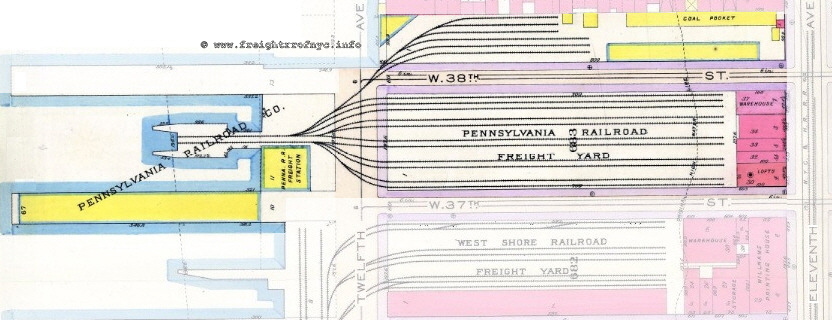
G. W. Bromley - 1909
.
According to the legends on the G. W. Bromley map indexes;
.
pink structures denote brick construction,
yellow structures are wood frame construction,
light brown denotes stone / concrete construction, and
yellow with blue outline denotes iron or metal sheathed wood construction.
I have included these construction types to give the reader a better sense of the many types of structure compositions that existed in these freight terminals.
By 1909, the West 37th Street Yard were quite large and contained a great variety of amenities and services, and in this authors opinion, this location was one of the better equipped Offline Terminal Freight Stations located in Manhattan.
In viewing all the G. W. Bromley Property Maps above, we can see that Twelfth Avenue ended at West 38th Street and a basin interrupting the right of way of that avenue.
We can also see that the Pennsylvania Railroad occupied Pier 77 (then numbered 67), but did not occupy Pier 78 (former Pier number 68), and we can see the close proximity of the West 37th Street Freight Yard to its rival West Shore / New York Central Railroad, just across the street to the south. We also see the triangular cattle pens existed at this early date as well as coal pocket and the original freighthouse.
The following is a Fairchild Aerial Survey Photo from 1924.

Fairchild Aerial Survey Photo -1924
NYPL Digital Archives
.
.
On 21 June 2010, Jim Guthrie forwarded the Port Facilities Map from 1924. Here is the portion showing the Pennsylvania West 37th Street Freight Yard:

Army Corp of Engineers Port Facilities Map - 1924
courtesy of J.
Guthrie
added 22 June 2010
.
.
In comparing the aerial image from 1924, and the 1950 Valuation Map below, the Pennsylvania Railroad expanded this facility a great deal when the block of buildings between West 39th and West 40th Streets would be razed. This would make room for the construction of the twin diagonal freight houses and an additional four tracks.
On 30 June 2009, I located the following images in the New York Public Library Digital Archives. The first photo is dated March 17, 1929 and shows the unique lattice frame overhead gantry crane at the Pennsylvania Railroad West 37th Street Freight Station. According to the 1950 ICC Valuation map seen below, this overhead gantry crane has a 30 ton capacity rating.
|
|
.
.
The next two images, while also from the NYPL Digital Archives, are erroneously marked for New York Central Railroad in the description, although it is without question that the structure in the photo is marked for the Pennsylvania Railroad.
The tall structure in the center of the image (behind the box truck) is the ventilation shaft for the first Lincoln Tunnel tube. The Empire State Building can be seen on the extreme right edge of the photo.
|
|
| .
. |
|
|
.
.
Considering the other offline terminals a little farther south in Manhattan (Erie, Lehigh Valley and Baltimore & Ohio), and upon the Pennsylvania Railroad's expansion to the block between West 39th and West 40th Street; the west 37th Street Freight Yard would become the largest offline terminal in the borough.

Pennsylvania RR Valuation Map - 1950
.
.
By 1950, as seen in the Pennsylvania Railroad Valuation Map
above, this facility offered:
three freight houses,
a two track thirty ton capacity overhead gantry,
livestock pens,
float bridge / carfloat service
carload and less than carload shipping and storage
two freight sheds located on the bulkhead, and of course
Pier Stations on Piers 77 and 78.
The image below, is an aerial photograph taken 1954. From left to right on the west side of the West Side Highway, we can clearly see: 5 loaded station / platform carfloats moored to both sides of Pier 77, the shadows of the twin float bridge gantries, what appears to be a centercab switcher parked by the north wall of the bulkhead shed, flanking the float bridge lead tracks.
On the east side of the West Side Highway, we see the triangular stock pens, the twin diagonal freight houses and the long narrow freight platform (running south east / northwest almost the entire length of the terminal) and the original freighthouse in the bottom right corner of the image.
The grid like object running lengthwise through the middle of the property is excavation work for the south tube of the Lincoln Tunnel, of which construction started in 1951 and completed in 1957. The larger open area towards the left of the opening will be the east ventilation shaft, visible in the 1966 aerial photo below, as the long shadow in the middle of the property.
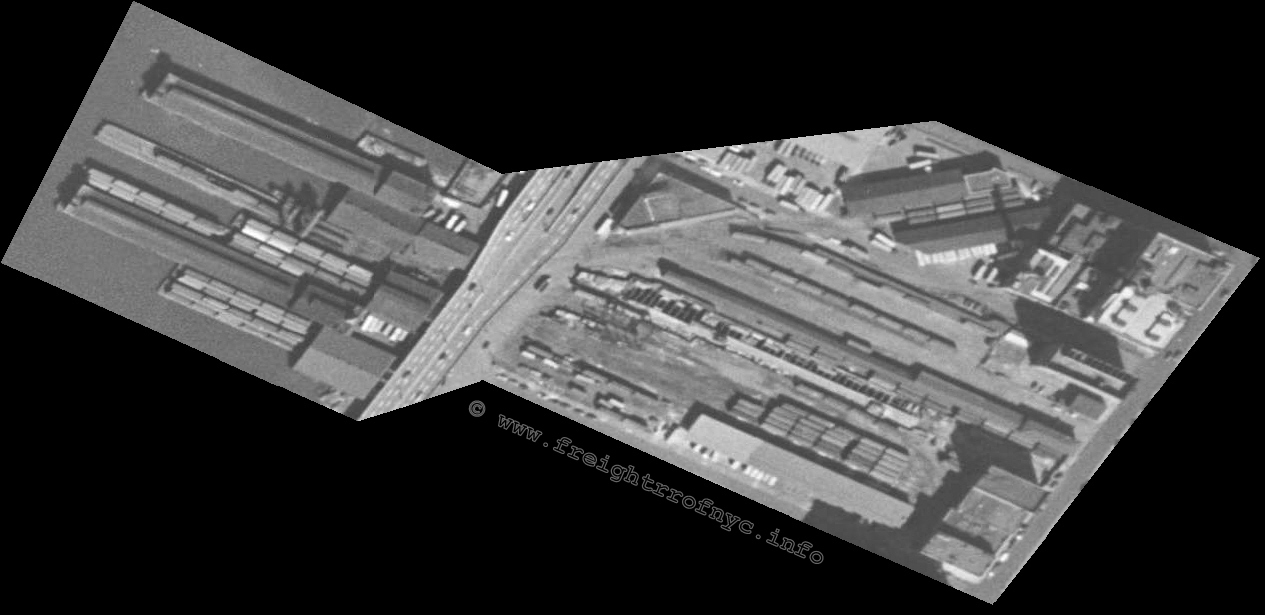
United States Geological Survey Aerial Photo -
1954
.
By 1966, Piers 77 and 78 would be razed and square building built to the north, and an extra wide pier to the south (out of view in the image below), and it is it is not known if the Pennsylvania Railroad was the occupant of either this new pier and / or structure.
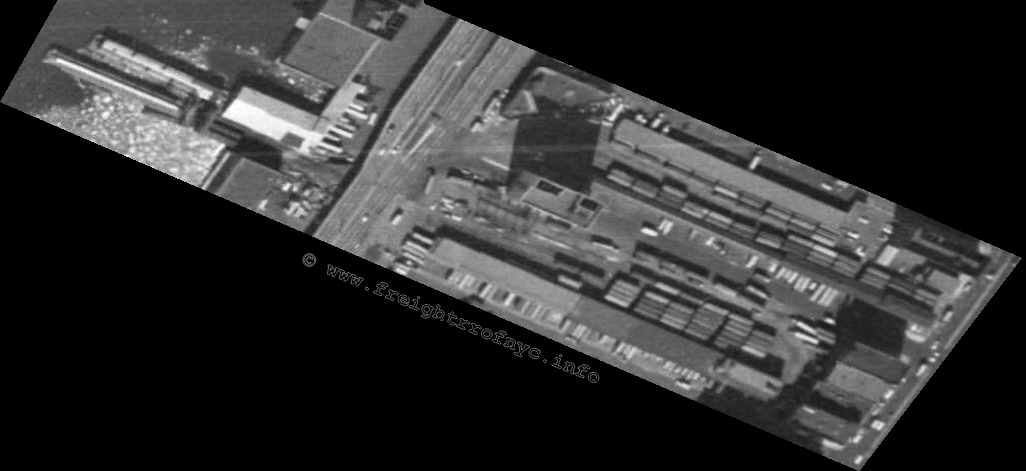
United States Geological Survey Aerial Photo -
1966
.
During 1970, a track connection would be installed between this facility and the former New York Central West 36th Street Yard across the street to the south. Both these yards at this date would be under the ownership of the Penn Central Railroad, and this track connection eliminated the need for the float bridge at this location. Therefore, the West 37th Street float bridge was taken out of service in 1971.
The photographs below, taken just prior to the installation of this track connection are in all probability, the last images taken of the West 37th Street float bridge in use.
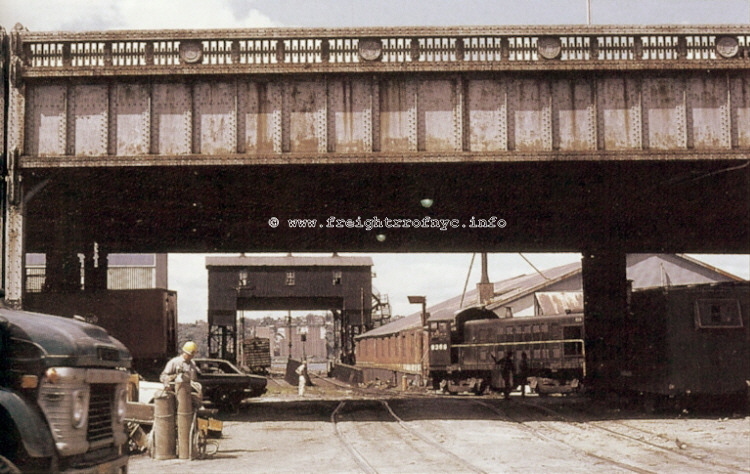
September 1970 |
| .
. |
|
|
.
.
It is unknown on what date the freight stations closed, but by 1980 the property is most decidedly vacant, with the structures appearing dilapidated and the float bridge and gantry completely gone.
.
.
.
As mentioned above, the Pennsylvania Railroad West 37th Street Freight Yard was opposite to Pier 77 and 78, which served as Pier Stations for the Pennsylvania Railroad.
These piers are visible in the 1924 Fairchild Aerial Survey Photo above and would demolished by 1966, in the United States Geological Survey aerial photo of that year.
These piers would accept and ship car load and less than carload freight. Freight would be transferred directly to and from the freight cars while loaded on the carfloats and moored to the piers.
|
|
| .
. |
|
|
| .
. |
|
|
.
.
The float bridge located the Pennsylvania Railroad West 37th Street facility, was a double apron overhead gantry type, which was quite unusual for a single float bridge location.
It is believed that this would be the only type of float bridge installed at this facility.
It is unknown on what date it was removed, but by viewing an aerial photo dated 1980, the float bridge and gantries are completely gone.
.
.
Steam Locomotives
Based on the start of operations date for the West 37th Street Freight Yard (ca. 1897); it is without question that steam locomotives must have operated at this location until at least 1925 and upon the passage of the Kaufman Act, which in effect eliminated the use of steam locomotives within city limits; those railroads operating with the city confines had to turn to alternate methods of motive power.
Pursuant to the initial
ratification of the Kaufman Act in 1923, this electrification
pre-empted compliance with the act, which was set to take full effect
by 1931. This became a moot point as the Kaufman Act was overturned as
unconstitutional by the US Statutory Court in 1926.
You can
read the comprehensive history of all steam locomotive restrictions for
the City of New York, beginning 1834 and ending with the Kaufman Act
and its repeal on the main page of this website:
The Kaufman Act when ratified, essentially banned steam locomotive operations in the City of New York; but was overturned in 1926 as unconstitutional by the US Statutory Court.
Therefore we see steam locomotives both at this facility and at Pennsylvania Railroad's North 4th Street operated possibly as late as 1928 or 1929, as such time when #3905 and / or #3906 (internal combustion locomotives) were constructed and delivered..
The overwhelming problem facing my current research at this time is that the Pennsylvania Railroad, being the "standard railroad" of the world, fielded such a large roster of locomotives conducive of switching operations (0-4-0T and 0-6-0T) and of which would be applicable at this facility (i.e: side / saddletank, fuel bunker mounted on locomotive).
According to "Pennsy Power" by Alvin Staufer; the PRR had on
their roster on July 1, 1924:
|
Granted, not all Class A or Class B locomotives would be of side / saddletank variety, but you can surmise the amount of locomotives that I would have to research just to determine which were and which were not of side / saddletank type, before even beginning to search through photographs to determine which were taken in Manhattan!
On top of which, most of the Class A and Class B locomotives were used at various roundhouses and service shops throughout the Pennsylvania Railroad system for shifting larger locomotives around, and with the Pennsylvania Railroad constructing and / or owning rather large fleets of steam powered switchers, it is unlikely any one locomotive was assigned permanently to this facility, not to mention the docks and wharfs in Philadelphia and the industrial sidings at Frankford Junction Terminal. The mere thought of attempting this research is giving me shudders!
This being the case, leaves it nearly impossible to find out exactly which locomotives had indeed operated at the Brooklyn and Manhattan locations and basically, the only way to learn which steam locomotives operated at this location would be by locating photographs. Unfortunately, no photographs of steam locomotives operating at North 4th Street Freight Station have surfaced to date.
So, therefore I call upon those Pennsylvania Railroad historians, experts and photo collectors and dealers to assist in this part of research.
To give a representative example of the type of locomotive that might be seen in Brooklyn and / or Manhattan; the following three steam locomotive images, are courtesy of North East Rails "Pennsylvania RR Steam Power Roster". Please keep in mind the pictured locomotives have not been confirmed to have operated in Brooklyn or Manhattan locations at this time, but are the locomotives that were most likely to have worked at these two Pennsylvania RR offline terminal locations.

Class A1: (formerly Class Q - 0-4-0T) - unknown location
years built: 1886-1892
quantity built: 8
driver diameter: 44"
unknown photographer
North East Rails
archives
added 12 March 2010
.
.

Class A2a (formerly class Q - 0-4-0T), unknown
location
years built: 1887-1891: Altoona, PA
quantity built: 7
driver diameter: 50"
unknown photographer
added 12 March 2010
.
.

Class A3a: (formerly Class A3 0-4-0T) - Meadows, NJ
years built: 1900-1902 - Altoona, PA
P. W. Prescott photo
collection of G. Mittner collection
added 12 March 2010
.
PRR #129 - A4 Class
We can definitely confirm the use of at least one A class 0-4-0 with slope-back tender, however the locomotive number is obscured, but the print is labeled #13; March 3, 1929. This date is significant for two reasons: first, the clock was ticking on the final revised enactment of the 1925 Kaufman Law.

.
.
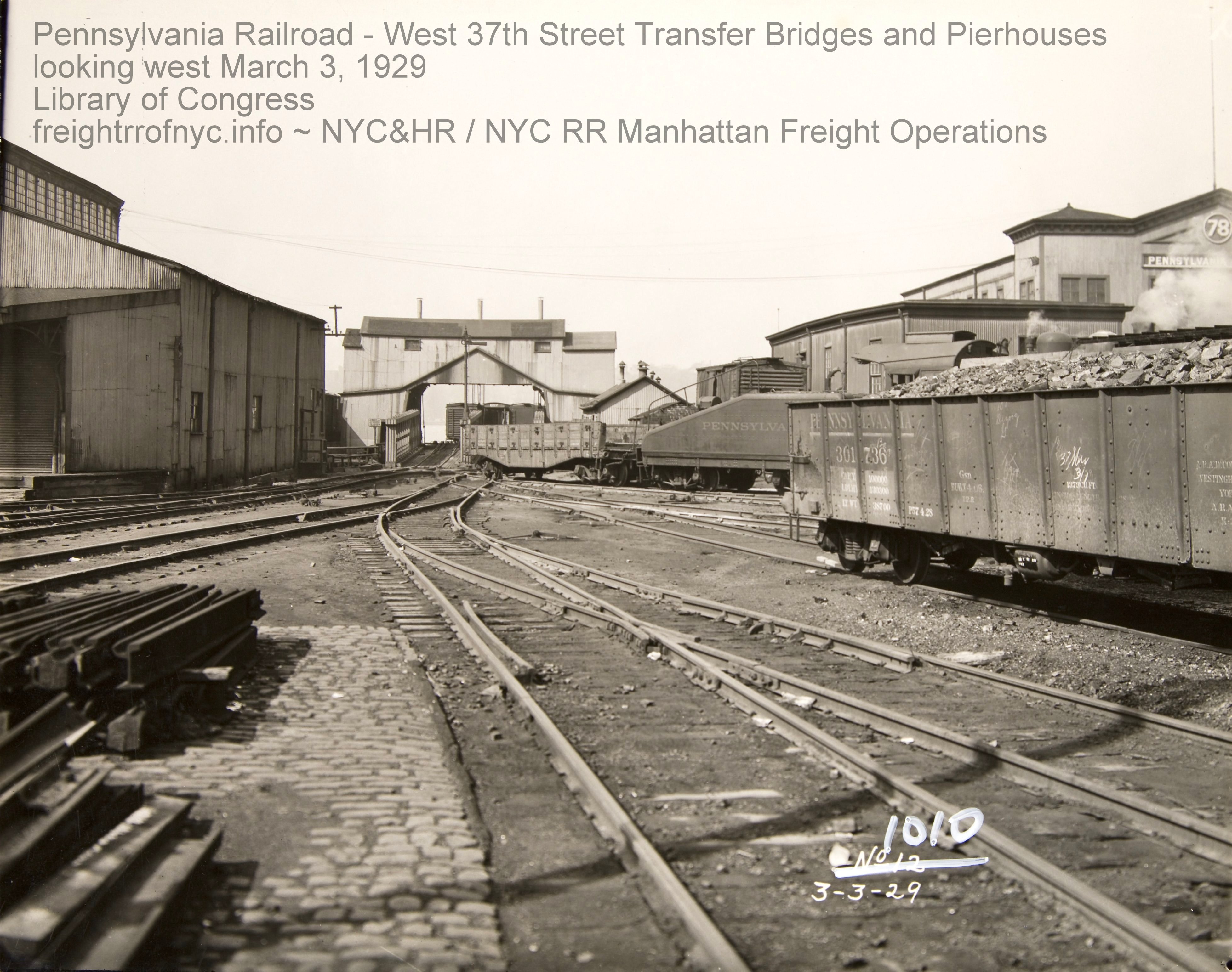
March 3, 1929
Internal Combustion Locomotives
While it is not known what steam locomotives were assigned to this yard, the "story" is slightly different for gasoline and diesel - electric locomotives and we currently and conclusively know of three such locomotives. But again, based on the large fleet of locomotives fielded by the Pennsylvania Railroad, it is very likely many more operated here.
.
PRR #3905 - A6 Class
#3905 is no stranger to the the offline terminals of New York area, as this locomotive has also been photographed in 1946, working the Pennsylvania Railroad's offline terminal located in Brooklyn, the North 4th Street Freight Station.
The following information is combined and courtesy of Sam Berliner's website (with J. F. Campbell information) and Pennsy Power II (A. Staufer & B. Pennybacker);
#3905 eventually completed May 22, 1928. It was equipped with an 8 cylinder solid injection 4 cycle diesel engine built by Bessemer Gas Engine of Grove City, PA. The engine was rated for 500 hp, and was mated to Westinghouse model 476 generator and model 355 traction motors. However, testing in Altoona Yards proved that the Bessemer engine could not handle the intended tasks, so that engine would be replaced with a Winton model 148 gasoline engine rated at 400 hp, with this change being duplicated to #3906.
Both locomotives retired prior to 1959.
.
PRR #3906 - A6 Class
Previously, it was thought that #3906 was assigned to another part of the Pennsylvania Railroad system, outside of New York. This is now known to be partially untrue, as the photographs below clearly show #3906 operating at the West 37th Street facility in 1936.
It is now apparent with #3905 being photographed at the West 37th Street facility as well, that both locomotives could very well be found at either facility, even though at this time we have no photographic proof of #3906 ever having been operated at the North 4th Street Freight Station.
Please take note:
As all of these locomotives operated at terminals within the New York City limits, these locations fell under the jurisdiction of the Kaufman Act. Therefore, it is only logical to conclude that the Pennsylvania Railroad and likewise the LIRR, a PRR subsidiary; constructed #403 A/B, as well as #3905 & #3906 in response to and as a direct result of the Kaufman Act. All three locomotives were constructed shortly after the first (or 1926) deadline of the Kaufman Act, with 403 A/B and #3905 being constructed in 1928 and #3906 following shortly thereafter in 1929.
.
PRR #3908 / PRR #5911 / PC #8511
On 28 March 2010, I happened to be on one of my "bored moment searches" on eBay. This means I hunker down with a snack and a drink, and do a general search without engine number or location. This day, I was searching through the hundreds of Pennsylvania Railroad locomotive photos. In regards to the Pennsylvania Railroad, this means looking at a long list of generic (and mostly uninteresting) photos.
Looking through the thumbnails, I happened across a image of a Pennsylvania diesel-electric switcher locomotive with a girder framework visible behind the engine. Even at the tiny thumbnail image size, I said to myself, "Wow, that girder framework looks familiar". I clicked on "enlarge", and the image opened to full size.
As I examined the image more closely, I noticed that the girder frame was in fact an overhead gantry (my original suspicion) that looked remarkably like the overhead gantry at West 37th Street. Unfortunately, the gantry and nothing else stuck out in the photo to identify the location. That is until I looked at the upper left corner of the image and saw a sign that reads: "Lincoln Tunnel / 40th Street Exit". Now I had no doubt, this was Manhattan!
And what about the locomotive? It was an SW profile bearing #5911. Ok, I now knew I had another locomotive to add to the roster. I took out my copy of Pennsy Power II (obtained from my father before he passed on... Thanks Dad!) and started looking for the diesel pages, but no #5911. There were a few Baldwin VO's in the 5900 range, but no 5911.
So I took a chance that the locomotive survived into Penn Central era, and looked up the locomotive number conversions PRR > PC in the back of Penn Central Bi-Annual. Sure enough, #5911 was renumbered Penn Central #8511. Flipping back to the model breakdown pages, I learned this was an EMC model SW1, or Pennsylvania Railroad Class AA5. Ok I thought, a "common" SW1. But reading further I was astounded to learn that #5911 was originally Pennsylvania Railroad #3908! Now that locomotive I knew from the two page spread in Pennsy Power II.
For those of you "not in the know", #3908 was Pennsylvania Railroad's first "GM" diesel locomotive. #3908 was built by "EMC" (ElectroMotive Corporation). In 1930, General Motors had the foresight to enter the diesel locomotive field with the purchase of the Winton Engine Company. Examining Winton sales records, GM decided to purchase Winton's primary customer, which was EMC. On January 1,1941 and following this great success of locomotive construction, GM merged the locomotive engine division of Winton and EMC into the "ElectroMotive Division of General Motors" better known in railroading industry as "EMD".
Fortunately, between Pennsy Power 2 and Penn Central Bi-Annual, the history on #3908 / #5911/ #8511 is plentiful:
#3908 was EMC construction number 680 as part of a one unit order from Pennsylvania Railroad (Order E170). #3908 would be constructed with the standard Winton model 201A eight cylinder engine, having an 8" bore by 10" stroke (which multiplied by the eight cylinders, equalled 4021 cubic inch / 335 cubic feet displacement). Horsepower rating was 600. EMC called this a "SW" model, as it was constructed with a welded frame as opposed to the "SC" which has a cast frame. The electrical systems, generator and traction motors came from General Electric.
In 1942, Pennsylvania Railroad would renumber #3908 to #5911. In 1958, this locomotive would be re-engined with an EMD 567A V6, which had the same horsepower rating.
Upon the creation of Penn Central (from the merger of Pennsylvania and New York Central Railroads) on February 1, 1968, #5911 would be renumbered #8511. As this locomotive was retired in April of that year, it would only carry her PC number for about two months.
At this time, it is unknown if this locomotive was permanently assigned to the West 37th Street Freight Yard, and if it was, during what period of time, or if this locomotive operated at this facility under #3908 or #8511.
Sadly from online research, it does not appear the #3908 / #5911 / #8511 survived the scrappers torch.
Thankfully however, with this "little" find on eBay; we have not only added a locomotive to the roster for this location but added a locomotive the fills the time gap in the roster between #3905 & 3906 and the Penn Central locomotive below. As fortune would have it; a rather historic locomotive at that!
.
PRR #9316 and #9344
After such a long period of idleness for this location, I happened across not one, but two slides of locomotives operating at this facility. These slides appeared on eBay on two separate occasions from two different sellers but within a few days of one another. And to add to the joy, the slides are of two different GE 44 Ton locomotives at West 37th Street Freight Yard.
The first slide was taken by Norman E. Kohl; is dated 2/18/1954 and is of #9316 working the float bridges. Matter of fact, if one looks closely enough, the engineer is reading a newspaper. Must have been break time or waiting for the bridgeman to finish securing the carfloat to the transfer bridge!
The second slide, dated 7 years later and from the collection of Al Chione, (but no photographer is listed) and is dated 4/15/1961. It shows GE 44 tonner #9344 working the yard in the early morning.
.
PRR #9321
Like before, news of a new locomotive at this location comes sporadically. Just acquired in Ocotber 2016 is a small print of #9321 working at West 37th Street on June 29, 1956. It is yet another GE 44 Tonner and the presence of a 44 Tonner at this facility seems to be a fairly regular assignment, which is to no surprise. The photo is not marked as to who took the image, but location and date were.
It should be noted at this point, that the Pennsylvania Railroad retired all their GE 44 Tonners (PRR class GS4 and GS4m) by late 1966.
.
PC #9369
The Allan Roberts photos of #9369 below provided a few hours of minor angst, followed by a few moments of joy for this author.
I have never been real knowledgeable regarding the Pennsylvania, New York Central or Penn Central Railroads. While Pennsy had a few locomotives I am fond of, (all their electric models, and a few of their weird experimental steam designs), I freely admit to not being very adept at researching the "common" locomotives.
Making matters worse, was the merger with New York Central forming the Penn Central. Making matters even more frustrating, was the conversion and merging of New York Central locomotive classification system with Pennsylvania's into the Penn Central's! (i.e: Penn Central #9369 was an ALCo model S3. As New York Central #901, this was a DES9 class. The Pennsylvania Railroad class for this model locomotive was AS6m, and while the Penn Central classed this locomotive as an AS6m as well, it was never a PRR locomotive!)
But those are just some of the problems incurred in and with research of this type. Then, at one o'clock in the morning, with a foggy brain and blurry eyes, I had a brain storm: reference my copy of "Penn Central System Bi-Annual" by Robert H. Reid. Sure enough after a few minutes of excitedly flipping pages, I found the AS6m roster which, is listed by manufacturer's model: ALCo S3! Simplicity in itself! (Thanks Mr. Reid, wherever you are...)
So #9369 had been identified, and its builder's information and its New York Central heritage listed.
.
PC#8285
After a rather long period of inactivity to this page, I was contacted by Bob Edmonson who looking to confirm the location shown in his image. I immediately identified the location as Pennsy's West 37 Street Freight Terminal, and then realized his image had a locomotive previously unknown to have worked at this location: Penn Central #8285, an EMD SW1. Well, one good turn deserves another, and Bob was gracious enough to allow his images to be used here.
So, we now have yet another locomotive to have worked this facility.
|
|
| .
. |
|
|
| .
. |
|
|
| .
. |
|
|
| .
. |
|
|
| .
. |
|
|
| .
. |
|
|
| .
. |
|
|
| .
. |
|
|
| .
. |
|
|
| .
. |
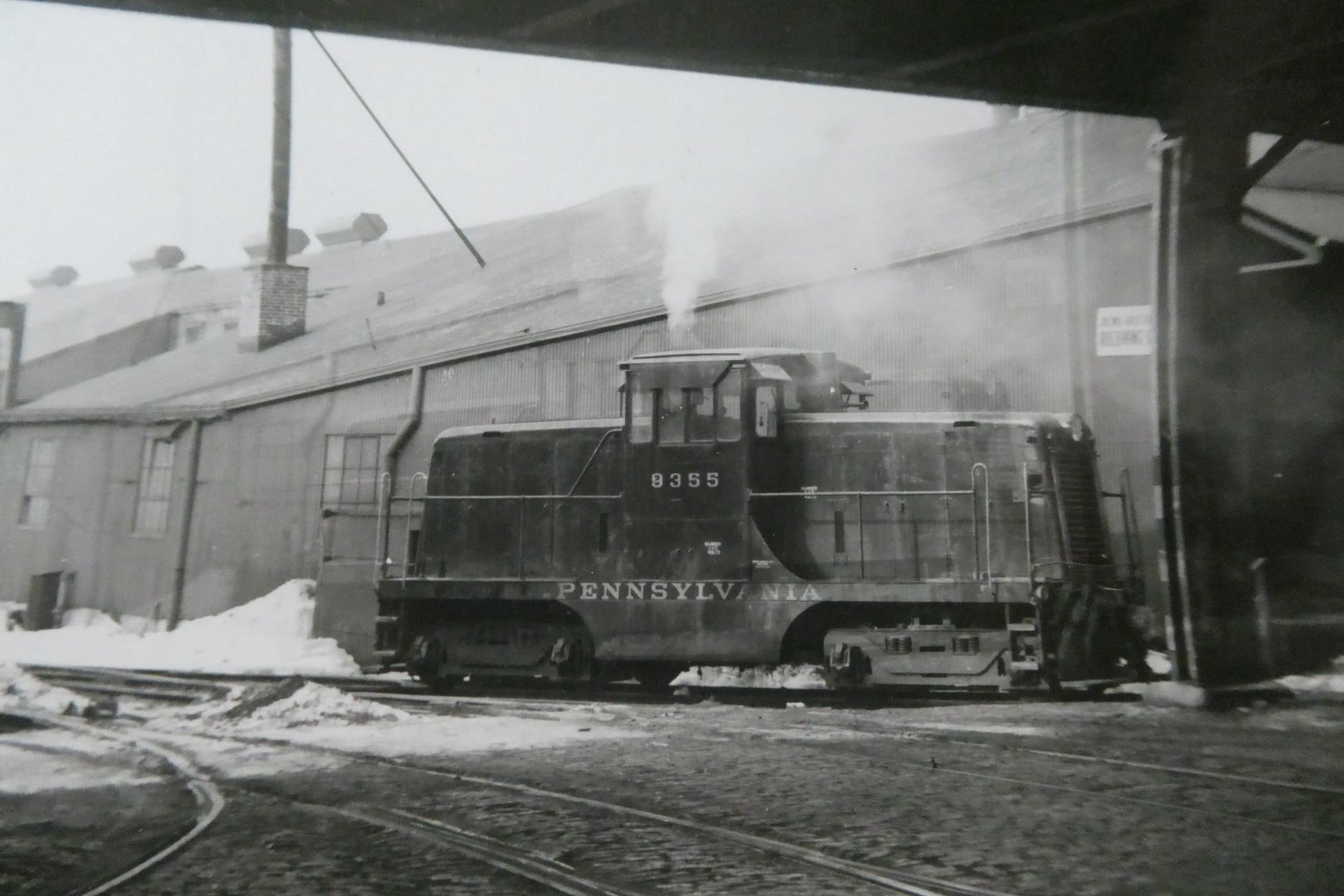 #9316 - unknown date - West 37th Street, Manhattan, NY submitted by R. Storey added 31 January 2021 |
| .
. |
|
|
| .
. |
|
|
| .
. |
|
|
.
.
West 37th Street Freight Station
(PRR) Locomotive Roster
| railroad | number / name | builder | c/n | build date |
gauge |
wheel arrangement |
model | driver dia. |
cylinders |
acquired |
notes / disposition |
notes | ref |
| PRR | 129 | PRR Juniata Shops |
2623 | 6/4/1913 | std. | 0-4-0 | 50" | 18.5" x 24" | scrapped July 1929 | PRR class A4 |
|||
| LIRR | 402 (1) | J. G. Brill | 22315 | 1/1926 | std. | B-B | 80 ton | used briefly at this location. returned within 14 days (some sources state 90 days) to J. G. Brill. Rebuilt, sold 1934 to GTW #7730 |
Class AA-3 This Brill 402 not to be confused with 109 ton GE/IR LIRR 402 (2) c/n 10465, 10/1928 |
||||
| PRR | 3905 | PRR Altoona Shops |
4193 | 5/22/1928 | std. | B | 38" | retired prior 1959 | PRR class A6 65 ton EMC c/n C24 (Winton 148 gasoline engine) |
[41] [45] [a] |
|||
| PRR | 3906 | PRR Altoona Shops |
4206 | 5/1929 | std. | B | 38" | retired prior 1959 | PRR class A6 65 ton EMC c/n C25 (Winton 148 gasoline engine) |
||||
| PRR | 3908 | EMC | 680 | 6/1937 | std. | B-B | SW1 | new | retired: 4/1968 | [c] 97 ton PRR class AAA5 / ES6 re# PRR 5911: 1942 re-engined 1952 re# PC 8511: 2/1968 |
[41] [42] |
||
| PRR | 9316 | GE | 30134 | 3/31/1949 | std. | B-B | 44 Ton centercab |
33" | new | all PRR 44 ton retired (except 9353 / 9999) by 1966 to Streigel Equip (D), Baltimore, MD |
[b] PRR Class GS4 seen in 1954 aerial image & 1954 slide |
||
| PRR | 9321 | GE | 30139 | 4/27/1949 | std. | B-B | 44 Ton centercab |
33" | new | all PRR 44 ton retired (except 9353 / 9999) by 1966 to Streigel Equip (D), Baltimore, MD |
[b] PRR Class GS4 |
||
| PRR | 9344 | GE | 29978 | 10/22/1948 | std. | B-B | 44 Ton centercab |
33" | new | all PRR 44 ton retired (except 9353 / 9999) by 1966 (damaged in fire 1962, scrapped) |
[b] PRR Class GS4 |
||
| PRR | 9355 | GE | 30244 | 8/5/1949 | std. | B-B | 44 Ton centercab |
33" | new | all PRR 44 ton retired (except 9353 / 9999) by 1966 to Streigel Equip (D), Baltimore, MD |
PRR Class GS4 Caterpillar D17000 (x2) 380hp B-B-88/88-4GE733 |
||
| PC | 9369 | ALCo | 78230 | 9/1950 | std. | B-B | S3 | used ex-NYC #901 |
unknown | ||||
| PC | 8525 | EMD | 11219 | 11/1950 | std. | B-B | SW1 | PRR class ES6 PRR #9425 to CR #8525 to WTSE #8525 disposition unknown |
Locomotive Footnotes:
| [a] | PRR #3905 & #3906 (A6)
specifications:
|
||||
| [b] | In the 1954 aerial image above, a centercab locomotive appears to be "parked" next to north wall of the bulkhead shed, just off the float bridge lead tracks. | ||||
| [c] |
|
||||
Sam Berliner has a remarkable website on Boxcab Locomotives. Please feel free to visit at:
Being a Pennsylvania Railroad operation; the Pier Stations and float bridge would have been serviced by the Pennsylvania Railroad marine fleet
Keeping in mind the significant fleet of marine equipment that the Pennsylvania Railroad owned and operated, a Marine Roster on this website would not be beneficial or justified; and therefore will not be forthcoming.
.
Like what you see? Suggestions?
Comments?